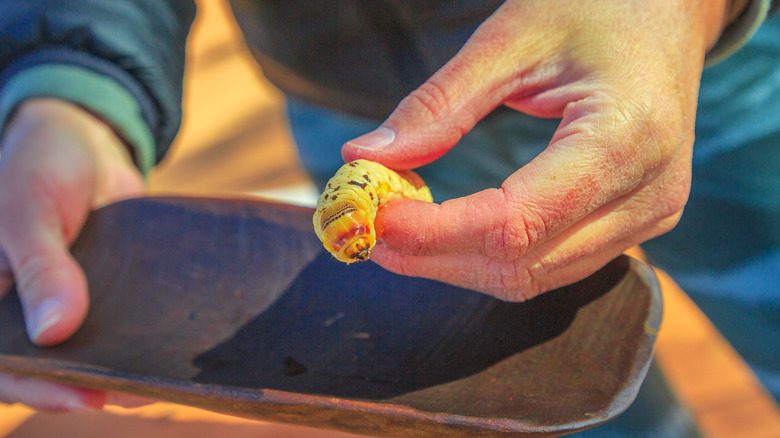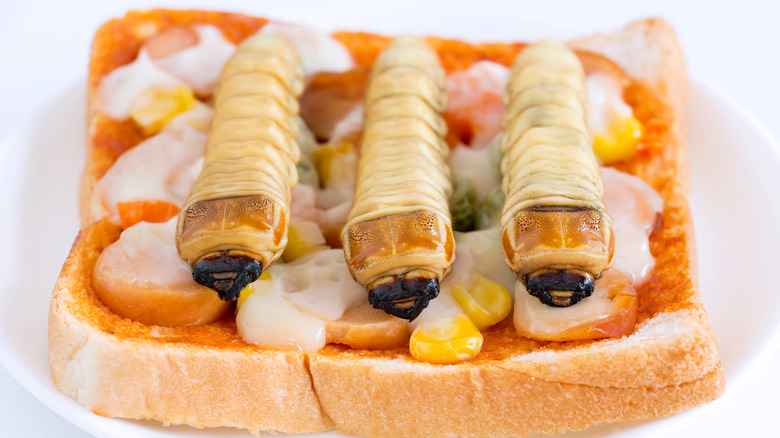Witchetty Grub: The Chubby Larvae You Can Only Try In Australia
In the U.S., there is a stigma around consuming insects. However, according to World Atlas, about two billion people around the world eat insects on a daily basis. Eating insects is a great source of nutrition and many are known to be high sources of protein. From crickets in Thailand to scorpions in China to grasshoppers in Mexico, many of these bugs make an appearance on global dinner plates, and Australia is no exception.
The witchetty grub is a rare delicacy that is native to the Australian outback, per Pilot Guides. The plump and chubby grub is a white, creamy color, and it is the larvae of the large cossid wood moth, according to the Australian Museum. They are a staple of indigenous diets in the country, and many women and children enjoy harvesting them. While the consumption of the grub has declined in recent years (via Slow Food), certain Australian restaurants have started featuring it on their menu next to other traditional fare.
Where the witchetty grub is eaten
The witchetty grub is exclusive to the Australian outback and can be found in the roots of witchetty bushes in the desert, according to Food & Wine. The indigenous people in these regions care for these bushes, as the grubs are an important food source for them.
Slow Food explains that the grub can be found throughout the Australian continent, but it is especially important in Central Australia. In this rugged region, there are very few sources of food that are as rich in important oils and proteins as the humble grub. However, the site notes that over the last couple centuries, insect eating has declined among indigenous groups in the country due to the influence of European diets.
Another reason for this decline is the grub's threatened existence. Factors such as overgrazing cattle and extended drought periods have killed many witchetty bushes. Similarly, increasingly hot summers and wild fires will continue to destroy the grubs' habitat.
How to eat the witchetty grub
Traditionally, witchetty grubs are eaten "live and raw," which is an easy and nutritious way to eat them, according to Pilot Guides. However, more typically, the grubs can be lightly grilled, then eaten. It is also important to note that the head of the grub is never eaten, as per Slow Food.
These barbecued witchetties are often eaten as an appetizer. Cooked over an open flame and strung onto wire, the grubs cook in a matter of minutes and boast a tender interior and crunchy exterior, explains Pilot Guides.
If you want to try the delicacy for yourself, you don't have to go on a foraging excursion. Australian supermarkets have started selling tins of witchetty soup, and some restaurants even serve it up on unique platters. According to Atlas Obscura, in restaurants that specialize in indigenous cuisine, called bush tuckers, witchetty grubs can be served as grilled entrées, alongside the dishes like "kangaroo tail soup, emu fillet, and flathead fish."
What does the witchetty grub taste like?
The taste of the witchetty grub varies depending on how it's prepared. Even though there is some general consensus on how each cooking method affects the grub's flavors, people's opinions are a bit all over the place. However, it seems that mostly meaty and nutty flavors are the first to come to mind when trying the grub for the first time.
If the grub is eaten fresh and raw, Food & Wine likens the taste to almonds or similarly nutty flavors. A slightly sweet flavor can also pop up, and make sure you brace yourself for the liquid-y center, warns Pilot Guides.
However, if the dish is cooked, most likely grilled, it can taste meaty. Pilot Guide describes the flavor as similar to "chicken or prawns with peanut sauce." Even more strangely, some believe it tastes like scrambled eggs or popcorn. But, that doesn't seem to be a bad thing, right? In order to get a better grasp on the flavor, it might be time for us to make the journey to an authentic bush tucker and try some Australian "grub" for ourselves.



